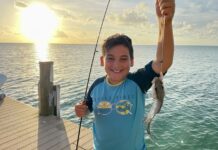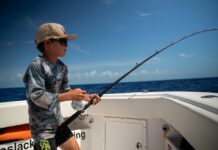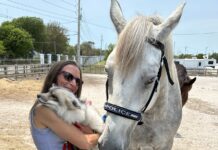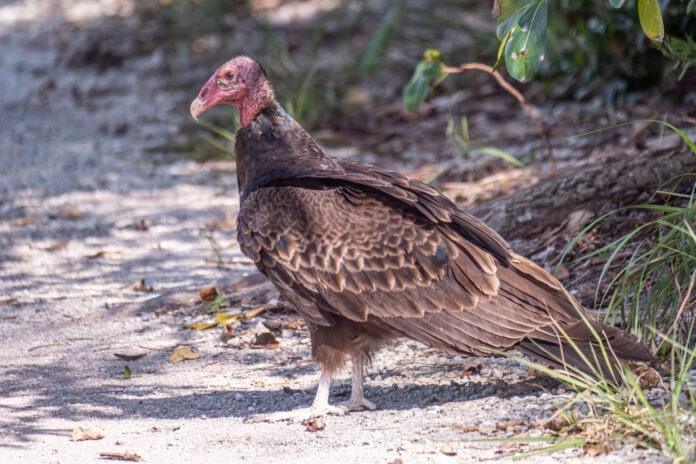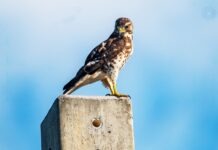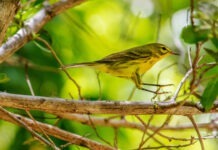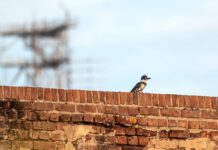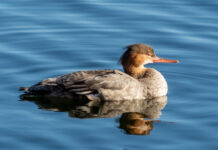The turkey vulture swooped low over the moat at Fort Zach, and I raised my camera because I knew it was going to shoot back up again and I would get a good shot. Except the bird didn’t shoot back up. It disappeared behind the bushes on what I presumed was the path.
Turkey vultures spend most of their day in the air, riding the winds, looking for food. They tend to only land on the ground when they have found something to eat. What do they eat? Almost exclusively dead things. Preferably dead things that have gone a little ripe.
Vultures are serious dietary opportunists. They’ll eat things as small as dead frogs, songbirds and mice, to things as large as the carcasses of cows, deer and alligators. They have been seen pulling bits from floating corpses of manatees. They will sometimes take a slow-moving, ground-dwelling chick, or a fish in very shallow water. They will also eat the occasional bit of coyote or sea lion poop.
And while all this is pretty gross, I will make the obligatory point that turkey vultures and other carrion eaters help keep the world clean. Without them the world would actually be a grosser – more gross? – place with a lot more dead things lying around for longer periods of time. Turkey vultures are one of the few carnivores that rarely take a life, but their guiltlessness, and their usefulness on the planet, generally don’t earn them a lot of love. The fact that they’re known for projectile vomiting as a mode of self defense probably doesn’t help.
At Fort Zach I started moving slowly towards the spot where the turkey vulture – the name usually shorthanded in birder world to TV – disappeared.
The path between the moat and the berm at Fort Zach is pretty well traveled. It was hard to imagine anything sizable, or noticeable to humans, dying and just being left there by the park staff. Thinking about what the vulture might be interested in, I believed it would most likely be an iguana.
I managed to advance far enough up the path to catch sight of the bird without scaring it off. Not that it didn’t notice me. It stood up a bit, straightened its posture, moved from the moat side of the path to the middle, fidgeting very slowly.
I’d say he looked like he was up to no good, but turkey vultures always look that way. It’s the lack of feathers on the head, and the wrinkled, red bare skin, which is functional for a creature that spends a good bit of time shoving its head into rotting corpses, but makes them look a bit like an aged, creepy viscount in a turtleneck. There is also the high, arching set of nostrils that are so wide and open that at least one birder was known to keep a list of plant species seen through turkey vulture nostril holes.
Their method of finding food was, for a long time, a controversial and bitterly debated subject. In John James Audubon’s era it was thought they found things by smell. When he was a young upstart in the world of ornithology, Audubon decided that no, that wasn’t the case, and wrote a paper with the brief and pithy title, “An Account of the Habits of the Turkey Buzzard (Vulture) particularly with the view of exploding the opinion generally entertained of its extraordinary power of smelling,” which he delivered to the Edinburgh Natural History Society in Scotland in 1826.
Audubon reported that to prove his point, he dragged an old pig carcass into a field and covered it with straw, and none of the turkey vultures in the area came to investigate. To further his point, he took a freshly dead rabbit and laid it near the straw-covered pig. Turkey vultures found it in a number of hours. He said he repeated this with several variations of dead animals and the results were always the same.
Some believed his conclusions. Many did not. Charles Waterton, a prominent English ornithologist of the era who had studied the turkey vulture, disagreed so violently that he suggested Audubon “ought to be whipped” for such a radical opinion. He went on to write at least 19 angry and virulent letters to the “Magazine of Natural History,” full of personal insults and withering grammatical critiques, ultimately inspiring the magazine to stop printing his letters and helping to shift public opinion in Audubon’s favor.
All of which demonstrates the pitfalls of a false dichotomy. Turns out TVs can find meals by both sight and smell. Audubon’s methodology was flawed. It is thought that the meat he used was too old and far gone. More modern experiments show that TVs are rarely interested in carrion that has been dead longer than four days. There is such a thing as too rancid, even for turkey vultures. There is a sweet spot for stink.
Multiple experiments in the modern era, which generally involve hiding corpses or meat of the right age under coverings or in forests, have shown that turkey vultures have an amazingly perceptive sense of smell, something that has allowed them to become the most populous vulture species on the planet.
One interesting use of the turkey vulture’s olfactory abilities was that of the Union Oil Co., which in the 1960s started putting ethyl mercaptan – the terrible smelling chemical that dead creatures emit – into their natural gas pipelines. They would then look for turkey vultures circling low over their pipelines in order to find the leaks.
Recent studies of turkey vulture brains have shown they have an olfactory bulb four times the size of a black vulture’s, as well as twice as many mitral cells, which transmit information about smells to the brain.
While I was watching, the TV on the path at Fort Zach would occasionally disappear into the bushes, but then come back pretty quickly to his spot in the middle of the path. I’m not sure how long I watched. Five, 10 minutes. I watched until a German tourist couple came walking down the path, saw the vulture, paused briefly, then continued on, flushing it, the bird gaining purchase on the air in an instant and disappearing over the horizon in a matter of seconds.
When everyone was gone, I walked over to where the vulture had been. Despite looking carefully, I couldn’t see anything. I couldn’t smell anything, either, though I do have a terrible sense of smell. But then I realized I was hearing a low undertone of soft buzzing, and I followed the sound until I found it – a dead iguana under a bush, swarmed by flies.
I wondered if anyone had ever done any experiments to figure out how far away a turkey vulture can hear the buzzing of a fly.





